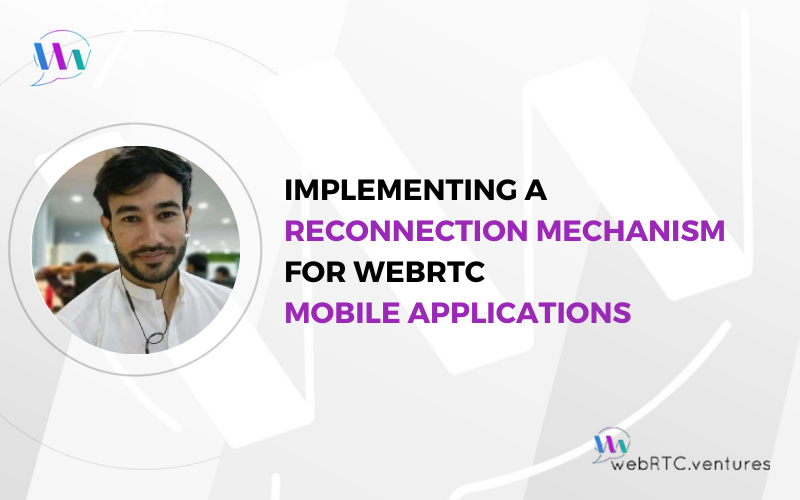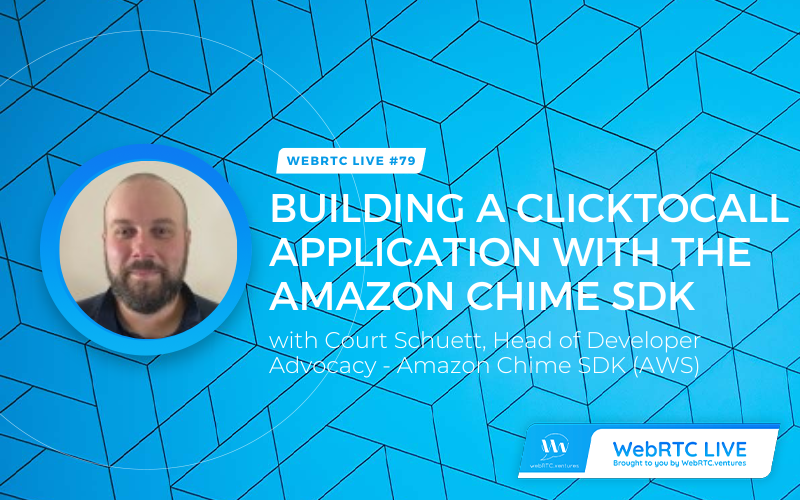June 28, 2023
JawadZeb
Comments Off on Implementing A Reconnection Mechanism for WebRTC Mobile Applications
Implementing A Reconnection Mechanism for WebRTC Mobile Applications
A lot can get in the way of network connectivity – be it human error, device failure, or environmental events – especially on mobile. A reliable connection is crucial for the successful transmission of video, audio, and data in a WebRTC application. So, when connectivity is compromised, you need to sniff out trouble quickly and reestablish the connection seamlessly. In this post, we will take a look at how to implement a reconnection mechanism for
June 26, 2023
Alberto Gonzalez
Comments Off on 4 Reasons to Modernize your Transcription Solution with AI
4 Reasons to Modernize your Transcription Solution with AI
Voice transcription refers to the process of converting spoken words into written text. Transcription solutions are in high demand in today's world, where real-time audio and video have become a primary form of communication. It plays a crucial role in making these communications more inclusive, accessible, and efficient. Transcription services have undergone a significant transformation with the integration of Artificial Intelligence (AI) capabilities. In this blog post, we will explore four reasons why upgrading your
June 21, 2023
Jen Oppenheimer
Comments Off on Watch WebRTC Live # 80: What’s Next for Jitsi and JaaS?
Watch WebRTC Live # 80: What’s Next for Jitsi and JaaS?
On June 21, 2023, Arin Sime welcomed Saúl Ibarra Corretgé, Principal Software Engineer at 8×8, open source and RTC pundit, and self-appointed Chief Jitsi Evangelist to the show. Saúl joined live from CommCon 2023! 2023 marks two milestones for the comprehensive open source meeting platform we now know as Jitsi. It was born twenty years ago when French University student Emil Ivov created SIP Communicator. It became WebRTC-compatible ten years ago. Another step in its
Delivering Great Telehealth Experiences
In a previous post, Delivering Great Experiences in WebRTC Applications, I shared our commitment to making the interactions in WebRTC applications as seamless as possible, allowing users to achieve their tasks without distraction. However, there’s more on the line with a healthcare application, so an outstanding user experience design (UX) is critical for telehealth. Let’s take a look at the pivotal role WebRTC plays in telemedicine and teletherapy services, as well as the challenges, opportunities
WebRTC.ventures visits AWS Summit Washington DC 2023
How should WebRTC video be used in the public sector? Since government is ultimately a reflection of society, the use cases are similar to many others we have built at WebRTC.ventures for our private sector clients. For example, we have integrated video into the contact center for sign language interpretation for both private and public sector clients. We have also built telehealth solutions for both the private and public sector, as well as group chat
5 Steps to Solve Your WebRTC Application Issues
Are you having poor video quality issues in your live video application? User interface complaints? Calls dropping? Ready to scale but concerned about latency? Maybe you’ve already built a prototype and you’re trying to select the best architecture to base your long-term solution upon? Or, you are thinking about switching CPaaS providers. Don’t reinvent the wheel. Tap into our experts with a WebRTC.ventures assessment. We’ve undoubtedly seen–and solved–your challenges before. Our team of WebRTC experts
June 1, 2023
Susana Fuentes
Comments Off on Leveraging Agile Methodologies for Optimization, Growth, and Adaptivity
Leveraging Agile Methodologies for Optimization, Growth, and Adaptivity
Effective project management and streamlined development processes are crucial for companies experiencing growth, especially when it comes to expanding technical teams. As organizations scale and the demand for innovative solutions intensifies, it is essential to ensure clear priorities and refined requirements to keep teams happy and productive and clients satisfied. This is where agile methodology steps in as a guiding force. WebRTC.ventures is a subsidiary of AgilityFeat, experts in staffing nearshore teams of highly specialized
May 24, 2023
Jen Oppenheimer
Comments Off on Watch WebRTC Live # 79: Building a ClickToCall Application with the Amazon Chime SDK
Watch WebRTC Live # 79: Building a ClickToCall Application with the Amazon Chime SDK
On May 24, 2023, Arin Sime welcomed Amazon Chime SDK (AWS) Head of Developer Advocacy, Court Schuett to WebRTC Live. Court gave us an in depth look at how to use WebRTC with the Amazon Chime SDK to create a Click to Call application that will bridge WebRTC to SIP. Court began by giving some introduction on the topics he will be discussing, beginning with a description of the two main Amazon Chime SDK offerings
WebRTC.ventures Joins the AWS Partner Network (APN)
WebRTC.ventures is proud to join the global community of developers who have attained an approval badge from Amazon Web Services (AWS) as an official AWS Partner. We’ve met a vigorous set of criteria, including knowledge, experience, and customer success requirements. As experts in the AWS Partner Network (APN), we are certified in using AWS cloud services, the most widely used platform in the world. As AWS Partners, we are uniquely positioned to help you accelerate
Call for Speakers: RTC Conference 2023
Call for Speakers! Our CTO, Alberto González, is once again chairing the WebRTC and Real-Time Communications track at the 2023 RTC Conference and Expo at the Illinois Institute of Technology in Chicago. At this annual event (in person October 3-5, 2023!), thought leaders from industry and academia gather to discuss, debate and shape the future of the rapidly changing real-time communications field. Everyone living at the intersection of voice, video, messaging, mobility, the cloud, and the Web
May 17, 2023
Hector Zelaya
Comments Off on Enhancing WebRTC Video Streams: Adding Text, Images, and QR Codes
Enhancing WebRTC Video Streams: Adding Text, Images, and QR Codes
In a previous post, we showed you how to perform background removal using the Insertable Streams for MediaTrack API and the VideoFrame interface of the WebCodecs API, as an alternative to HTML Canvas elements. Having just scratched the surface of what a complete live video processing pipeline looks like, today we will expand on this functionality. We will add the ability to manipulate video streams in order to add text and overlay images (even a
Adding a Voice Bot to Your WebRTC Application
A voice bot, also known as a voice assistant, is a type of bot that uses natural language processing (NLP) and text-to-speech (TTS) technology to interact with users via voice commands. Voice bots are designed to respond to spoken requests and provide information or perform tasks in a conversational manner. One key difference between voice bots and regular chatbots is the way they interact with users. Voice bots use speech recognition to understand spoken requests,
Delivering Great Experiences in WebRTC Applications
At WebRTC.ventures, we believe that a technically-sound WebRTC application is insufficient if it doesn't provide a positive user experience. We prioritize great experiences above all else, recognizing that even the most advanced application is a failure if it doesn't meet the user's needs. We have a talented team of UX designers to make an experience that is: Seamless and intuitive Clear and timely with regard to feedback Optimized for differences Conquers the tricky terrain of
May 10, 2023
Jen Oppenheimer
Comments Off on Eliminate the After Call Work with AI-Powered Summaries, Notes, & Actions
Eliminate the After Call Work with AI-Powered Summaries, Notes, & Actions
Enabling real-time call intelligence like sentiment analysis, question insight, and automated summaries for contact agents and similar use cases can accelerate customer interactions and reduce "after-call" work duties by up to 15 seconds. On Wednesday, May 17 at 12:00 p.m. ET, our CEO and Founder, Arin Sime, will be participating in a discussion and demo illustrating the results of AI-powered conversation intelligence from Symbl.ai and the Vonage platform - working together in a video solution built by us at WebRTC.ventures. The
Which Sentiment Analysis Tool is Right for You?
Sentiment analysis tools use natural language processing and machine learning techniques to identify, extract, and quantify subjective information from textual data. The ability to reveal feelings and emotions hidden behind a text or interaction has proven extremely useful in brand analysis, PR strategy, market research, business and financial intelligence, social media monitoring, and many more use cases. Sentiment analysis tools can be integrated into various forms of communication and are especially valuable for WebRTC live
April 28, 2023
Hector Zelaya
Comments Off on How to Build WebRTC Applications Using CPaaS, Part Three: Popular Options
How to Build WebRTC Applications Using CPaaS, Part Three: Popular Options
From the previous two posts in this series, you know how CPaaS works and the overall process to implement a CPaaS in your application. Now, it’s time to see how these steps are performed - at least at the time of writing this post - in three popular providers who we partner with here at WebRTC.ventures: Amazon Chime SDK, Daily, and the Vonage Video API. Amazon Chime SDK Create an account Amazon Chime SDK is
WebRTC.ventures visits HIMSS 2023
How has the role of WebRTC in healthcare changed in recent years? It has been a few years (and a pandemic) since our team at WebRTC.ventures has been able to attend a HIMSS conference on healthcare IT. Our CEO and Founder Arin Sime headed out to the HIMSS 2023 conference in Chicago to see the latest advances. In the video below, Arin talks about different companies that he met, and the ways that WebRTC video
WebRTC.ventures Visits NABShow 2023
What is the role of WebRTC in the broadcast industry in 2023? To find out, WebRTC.ventures CEO and founder Arin Sime attended the National Association of Broadcasting (NAB) annual conference, NABShow 2023, in Las Vegas on April 17th and 18th. For a video overview of the conference, Arin recorded this report, which we then expand on in the blog post below. While attending the NABShow, I had the chance to attend a number of talks
April 20, 2023
Hector Zelaya
Comments Off on How to Build WebRTC Applications Using CPaaS, Part Two: The Implementation
How to Build WebRTC Applications Using CPaaS, Part Two: The Implementation
In this first part of this series on How to Build WebRTC Applications Using CPaaS, we explored why using a CPaaS is helpful when building live video apps. In this second post, we will explore how to use a CPaas. The specific implementation steps will vary depending on the provider (more on that in the third post!), but the overall process is very similar for all of them. The steps to implement a CPaaS are:
April 14, 2023
Hector Zelaya
Comments Off on How to Build WebRTC Applications Using CPaaS, Part One: The Why
How to Build WebRTC Applications Using CPaaS, Part One: The Why
In a previous post, we explored whether a CPaaS was right for your WebRTC application. We talked about the things to consider when deciding whether to use a Communication-Platform-a-Service (CPaaS) provider in a WebRTC application. Building a WebRTC application is a complex process. (We can help!) A CPaaS makes it simpler through a set of Application Programming Interfaces (API) and Software Development Kits (SDK). In this first part of a series on How to Build


























